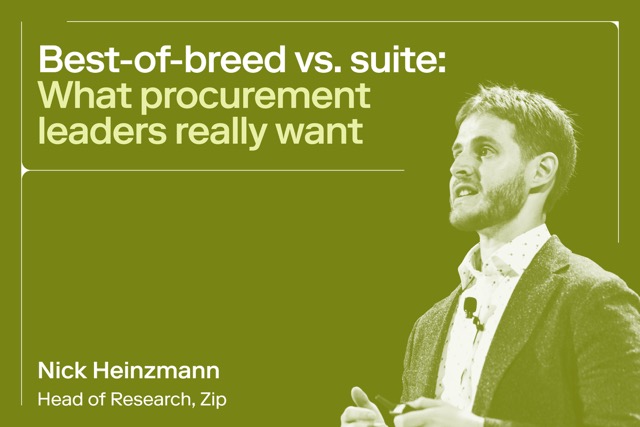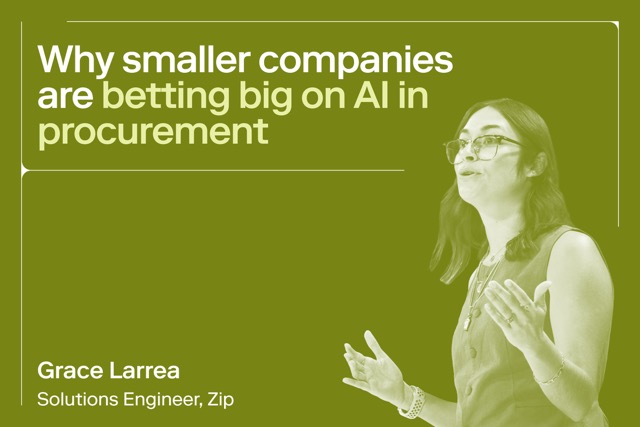.webp)
Why ERP isn’t enough: A guide for modern procurement teams
Modern procurement needs flexibility, real-time analytics, and visibility.

Enterprise Resource Planning (ERP) systems have traditionally been the workhorses of procurement, serving as a centralized platform for managing and streamlining a host of critical functions like purchase order management, supplier collaboration, and contract management. However, the business landscape is rapidly changing, and the demands on procurement teams have significantly evolved. Today's procurement requires flexibility, real-time analytics, comprehensive visibility, and a user-centric approach–areas where traditional ERP systems often fall short.
These limitations of ERP systems have made room for disruption in the procurement space. Modern procurement solutions like Zip are addressing these challenges by providing an intake-to-pay approach, a more intuitive interface, and better integration capabilities, leading to improved efficiency, visibility, and user adoption. This article discusses the importance of procurement in business operations, the role of ERPs in procurement management, and the key features to look for in an ERP for procurement. It also offers guidance on choosing the right ERP for your business and provides best practices for implementing an ERP system.
Understanding ERP’s Role in Procurement
What is an ERP (Enterprise Resource Planning) System?
ERP, or Enterprise Resource Planning, refers to the software solutions used by businesses in managing their day-to-day operations. The software integrates various processes across departments, including financial management, human resources, and customer relationship management. By providing a centralized platform for managing data and workflows, ERPs help businesses streamline their operations and achieve greater efficiency. ERPs for procurement, in particular, provide an integrated solution for managing the procurement process.
Importance of procurement in business operations
The process of procurement refers to the acquisition of goods and services required for business operations. Efficient procurement is essential for businesses in ensuring seamless production and delivery of products or services. Procurement also plays a crucial role in inventory management and supply chain strategies. With the increasing complexity of global supply chains, businesses need a comprehensive tool to effectively manage procurement processes, from identifying suppliers and generating purchase orders to receiving goods and paying invoices, all while ensuring compliance with industry guidelines and regulations.
Role of ERPs in procurement management
ERPs have revolutionized procurement management by providing an integrated solution that enables businesses to automate and optimize their procurement processes. ERPs for procurement automate the entire procurement cycle, from requisition to payment, eliminating manual processes and minimizing errors.
They also provide real-time visibility of inventory and supplier performance, offering valuable insights for making informed procurement decisions. ERPs enable businesses to improve supplier relationships and negotiate better contracts, resulting in cost savings and increased efficiency. With ERPs, businesses can unlock major efficiencies and savings, making them a sound investment for any organization looking to optimize its procurement processes.
Benefits of using an ERP for procurement
Streamlined procurement processes
This technology allows businesses to automate procurement workflows, making it possible to track orders, manage inventory levels, and streamline payment processes. With ERPs, procurement teams can also easily manage vendor relationships, negotiate contracts, and manage supplier risk. These benefits can lead to reduced purchase and invoice processing times, reduced manual effort, and improved productivity overall.
Enhanced collaboration and communication
By providing a centralized platform for all relevant stakeholders, including purchasing, finance, and inventory management teams, ERPs enable real-time updates and exchanges of information. For example, Zip's integration capabilities allow it to provide real-time visibility into open purchase orders, invoices, and payments.
This feature provides stakeholders better visibility, accountability, and control over procurement activities, helping to align procurement activities with business goals and strategies. For instance, management and the finance department can plan and budget more efficiently with better visibility into budget variances and other key metrics.
Improved decision-making with real-time data
With real-time data visibility, companies can make better decisions concerning supplier selection, pricing, and discounts. With real-time visibility, companies can also analyze their spending patterns and identify opportunities for cost savings. The system's analytics and reporting tools can provide detailed information such as item-level inventory, purchasing history, and customer demand trends, which helps organizations make data-driven decisions.
Reduced operational costs and risks
With the automation of procurement tasks, businesses can realize cost savings by reducing manual tasks and eliminating errors that can lead to costly rework. Additionally, the system's real-time monitoring and alert capabilities help to address operational risks before they become major issues. Along with cost savings and risk reduction, ERPs can also improve cash flow management, reducing the need for short-term loans and accelerating payment cycles.
Increased compliance and reduced risk of fraud
The system provides better transparency and traceability, making it easier to maintain legal and regulatory compliance across multiple geographies. The automation of procurement processes also reduces the potential for fraud and wasteful spending by enforcing proper approval workflows and internal controls. Moreover, with the ability to audit and analyze procurement data, businesses can reduce the risk of procurement fraud, human errors, and compliance violations, which helps to protect the company's reputation and maintain compliance standards.
Key Features to Look for in an ERP for Procurement
An effective ERP system can transform your procurement operations, driving efficiency and cost savings. When evaluating various ERP solutions, consider the following essential features that can make a significant impact on your procurement process:
Integration with Existing Systems
Seamless integration with your current business systems is crucial for a smooth transition to an ERP system. Ensure that the ERP solution you choose can integrate with your financial, inventory, and supply chain management systems, enabling data sharing and collaboration across all departments. For instance, Zip's ability to function as a procurement orchestration and intake-to-procure layer on top of legacy ERP systems provides real-time data sharing and collaboration across all departments. This will eliminate the need for manual data entry, reduce errors, and save time.
Centralized Data Management
A robust ERP for procurement should provide a centralized database to store and manage all procurement-related information. By consolidating data from various sources, your organization can gain better visibility into supplier performance, order status, and inventory levels. This comprehensive view will empower your team to make informed, data-driven decisions and improve overall procurement efficiency.
Automated Workflows
Automation is a key feature of an ERP system that streamlines and simplifies procurement processes. Look for an ERP that offers automated workflows for purchase requisitions, approvals, and order management. This will not only save time but also reduce the risk of human error, ensuring consistency and accuracy throughout the procurement process.
Customizable Reporting and Analytics
In today's data-driven business environment, having access to real-time analytics and customizable reporting is essential. Your ERP solution should offer dynamic reporting tools that allow you to create custom reports, analyze trends, and monitor key performance indicators (KPIs). This will enable your organization to make well-informed decisions and optimize procurement strategies to achieve better results.
Supplier Management and Performance Tracking
An ERP system that offers comprehensive supplier management capabilities can significantly improve your procurement process. Look for features that allow you to track supplier performance, evaluate risk factors, and maintain up-to-date supplier profiles. This will help you establish strong relationships with reliable suppliers, negotiate better terms, and minimize risks associated with supplier disruptions.
Purchase Order and Invoice Management
Efficient management of purchase orders and invoices is critical for a successful procurement operation. Choose an ERP system that simplifies these processes by offering features such as automated order creation, tracking, and approval, as well as electronic invoicing and payment processing. This will not only save time but also improve accuracy and compliance with industry regulations.
Inventory Control and Demand Planning
Effective inventory management is crucial to avoid stockouts and excess inventory costs. A sophisticated ERP solution should offer advanced inventory control and demand planning capabilities. By leveraging historical data and demand forecasting algorithms, your organization can maintain optimal inventory levels and reduce costs associated with excess stock or stockouts.
Selecting an ERP solution with these key features will enable your business to streamline procurement processes, improve decision-making, and ultimately achieve significant cost savings. Make sure to thoroughly evaluate each solution and choose the one that best aligns with your organization's needs and objectives. By doing so, you can unlock the true potential of your procurement operations and drive sustainable growth for your business.
How to choose the right ERP for your business
Assessing your business needs and goals
Before choosing an ERP solution for procurement, it's essential to assess your business needs and goals. Consider the specific challenges and pain points you want to solve, such as reducing manual processes, improving supply chain visibility, or streamlining purchasing. Furthermore, identify your long-term objectives, such as expanding to new markets or achieving sustainable procurement practices. By aligning your ERP selection with your business strategy, you can ensure that the solution will meet your present and future requirements.
Comparing different ERP solutions and vendors
Comparing different ERP solutions and vendors is a crucial step in finding the right procurement system. Use a checklist or scorecard to compare the features, functionality, and benefits of each solution, such as automation capabilities, integration with other systems, and customization options. Also, evaluate the vendors' reputations, experience, and customer support to ensure a successful implementation and long-term partnership. By doing this research, you can select an ERP provider that matches your business needs and fits within your budget.
Evaluating scalability and flexibility
When evaluating ERP solutions for procurement, scalability and flexibility are vital considerations. A system that can accommodate growth and changes to your operations while also adapting to industry trends is essential. Ensure that the system can scale up or down as needed, integrate with new software or hardware, and support mobile and remote access. A flexible ERP system will allow your procurement department to stay agile and competitive in the fast-moving business environment.
Ensuring data security and compliance
Data security and compliance are paramount in procurement, where sensitive information such as supplier contracts and pricing agreements is exchanged regularly. Ensure that the ERP solution you choose includes robust security features such as role-based access controls, encryption, and vulnerability testing. Additionally, verify that the vendor complies with industry standards and regulations such as GDPR, SOC 2, or ISO 27001. By selecting an ERP solution with reliable security and compliance measures, you can protect your data and reputation.
Considering total cost of ownership (TCO) and return on investment (ROI)
When considering a comprehensive guide to ERPs for procurement, the total cost of ownership (TCO) and return on investment (ROI) are critical factors. TCO includes not only the upfront software and hardware costs but also the ongoing maintenance, upgrades, and support expenses. ROI examines the benefits of implementing an ERP solution, such as cost savings, efficiency gains, and revenue growth, compared to the investment. Analyzing both TCO and ROI can help you make an informed decision and justify the procurement ERP investment to stakeholders.
Asking for references and conducting thorough research
Finally, after completing the above steps, it's essential to ask for references and conduct thorough research on ERP vendors. Reach out to their current customers and inquire about their experience with the solution, including ease of use, customer support, and overall satisfaction. Also, research the vendor's reputation, history, and leadership to ensure a reliable and trustworthy partner. By consulting references and conducting proper research, you can gain valuable insights and select an ERP provider that aligns with your procurement goals and culture.
Implementing ERP Software for Procurement: Best Practices
Successfully implementing an ERP for procurement can deliver significant benefits to your organization, but it requires careful planning and execution. To ensure a smooth transition and maximize the value of your investment, follow these best practices:
Developing a Comprehensive Implementation Plan
Start by creating a detailed implementation plan that outlines the project's scope, objectives, and timeline. This plan should include milestones, resource allocation, and clearly defined roles and responsibilities for each team member. Regularly review and update your plan to account for any changes and ensure that your project stays on track.
Appointing an ERP Project Team
Assemble a dedicated project team consisting of key stakeholders, including representatives from procurement, IT, finance, and other affected departments. This cross-functional team should collaborate closely throughout the implementation process to ensure that all aspects of the ERP system are thoroughly tested, integrated, and optimized.
Communicating the Change to Stakeholders
Effective communication is essential for the success of any ERP implementation. Develop a communication plan to keep all stakeholders informed about the project's progress, benefits, and potential challenges. This transparency will help to manage expectations, address concerns, and foster a positive attitude towards the new system.
Prioritizing Data Migration and System Integration
Migrating data from your existing systems to the new ERP solution is a critical and complex task. Begin by cleansing and validating your data to ensure its accuracy and integrity. Develop a data migration strategy that outlines the process, tools, and resources needed to transfer data smoothly and securely. Additionally, ensure that your new ERP system integrates seamlessly with your existing software and hardware infrastructure to maintain business continuity.
Ensuring Proper Training and Support for Users
To maximize the benefits of your new ERP solution, it's essential that all users understand how to effectively use the system. Develop a comprehensive training program that covers key features, best practices, and real-life scenarios. This may include a combination of classroom training, hands-on workshops, and online resources. Ensure that ongoing support is available to assist users with any questions or issues that may arise.
Continuously Monitoring, Evaluating, and Optimizing the System
Once your ERP system is live, it's crucial to continuously monitor its performance and identify areas for improvement. Establish key performance indicators to track the system's effectiveness and impact on your procurement operations. Regularly review these KPIs and use the insights to optimize processes, workflows, and system configuration. This will help you to maximize the value of your investment and drive continuous improvement in your procurement operations.
Overcoming Common Challenges in ERP Procurement Adoption
Successfully adopting an ERP system for procurement can be transformative for your business. However, it's crucial to address common challenges that may arise during the process to ensure a smooth transition and maximize the potential benefits. By understanding these challenges and proactively developing strategies to overcome them, you can confidently navigate the adoption process and optimize your procurement operations.
Identifying and addressing potential risks
Conduct a thorough risk assessment to identify potential issues that could impact the ERP procurement adoption process. Potential risks may include data migration errors, inadequate user training, or insufficient support from your vendor. Once identified, develop and implement appropriate risk mitigation strategies to minimize the impact of these risks on your project.
Managing user resistance and expectations
User resistance can pose a significant challenge during the ERP procurement adoption process. Addressing this resistance begins with effectively managing user expectations. Communicate the benefits of the new system, and ensure that employees understand how it will enhance their daily tasks and overall procurement performance. Providing comprehensive training and support, as well as involving users in the decision-making process, can help foster a sense of ownership and commitment to the new system.
Software Sprawl
Software sprawl, or the unchecked proliferation of software applications across an organization, has become a major challenge in modern procurement and represents a significant limitation of traditional ERP systems. The expansive and intricate nature of modern procurement often requires specialized software to handle specific tasks, and ERP systems tend to lack this granular capability. As a result, organizations resort to integrating various disparate software tools with their ERP system to accommodate their procurement needs.
This can lead to an uncontrolled increase in the number of applications, causing software sprawl. Not only does this create complexities in managing and integrating various systems, but it also results in data silos and disjointed processes, reducing visibility, and hindering the overall efficiency of procurement operations. Furthermore, tracking and managing licenses and usage for this myriad of software applications can be a daunting task, creating compliance risks and cost inefficiencies. These challenges highlight the need for more comprehensive solutions like intake-to-pay systems, which are designed to effectively address the issue of software sprawl in modern procurement.
Customization Challenges
Every organization has unique needs, and an ERP system might not meet all these requirements out of the box. Customizing an ERP to suit specific procurement needs can be complex, time-consuming, and expensive. ERP systems are generally designed to cater to a broad range of business processes, and while they usually include procurement modules, these may not always offer the level of specificity required for certain procurement tasks. This lack of specific functionality can mean that procurement teams have to rely on additional specialized tools to supplement their ERP.
Ignoring Intake
In the procurement process, the intake stage is often overlooked, particularly when it comes to software and other intangible goods. This is the initial stage where procurement needs are identified and defined, often in response to a request from a department or individual within the organization. A common mistake that organizations make is failing to consider how these intangible assets will be tracked once they have been procured. Intangible assets like software licenses, digital media, or services, often don't physically exist in a way that can be easily monitored and managed.
They require unique tracking mechanisms, which if not established, can result in a lack of visibility and control over these assets. This oversight can lead to downstream issues such as software over-licensing or under-licensing, difficulties in asset utilization, and challenges in managing contractual compliance. In some cases, the inability to properly track and manage these assets can even lead to legal and financial repercussions.
Ensuring data security and compliance
Data security is a critical concern during the ERP procurement adoption process, particularly when migrating sensitive information from legacy systems. Work closely with your vendor to ensure that the new system adheres to industry standards and regulatory requirements. Implement robust access controls, and provide training to users on best practices for maintaining data security and privacy. Regularly review and update your security measures to protect your valuable procurement data.
Coordinating with vendors and other stakeholders
Successful ERP procurement adoption requires seamless collaboration among various stakeholders, including your internal team, software vendor, and third-party service providers. Establish clear communication channels and ensure that all parties are aligned on project objectives, timelines, and responsibilities. Regularly evaluate the performance of each stakeholder, and address any concerns or bottlenecks that may arise during the process.
By proactively addressing these common challenges, your organization can successfully navigate the ERP procurement adoption process and unlock the full potential of your new system. As you streamline your procurement operations, you'll enjoy enhanced efficiency, improved visibility, and a competitive edge in today's fast-paced business environment.
Intake-to-Pay: The Next Evolution in Procurement
The procurement landscape has evolved significantly over the years, and the advent of the intake-to-pay process represents its latest phase. Intake-to-pay extends beyond the traditional procure-to-pay process, beginning at the very initial stage where the need for a product or service is recognized and defined.
Why ERP Systems Alone No Longer Suffice
ERP systems have been instrumental in integrating various business operations and improving overall efficiency. However, as the procurement landscape becomes increasingly complex and digital, ERP systems (even with typical add-ons) often fall short in adequately managing the entire procurement process.
Most ERP systems are not inherently designed to handle the complexity of modern procurement, particularly when it comes to managing the intake and tracking of software and other intangible goods. They also tend to lack the advanced analytics and reporting capabilities needed to gain insights into procurement data and optimize procurement strategies.
While some organizations attempt to overcome these limitations by supplementing their ERP systems with additional tools, this often leads to disjointed processes and data silos, creating inefficiencies and reducing visibility. This is why many organizations are turning to intake-to-pay solutions, which offer a more comprehensive and streamlined approach to procurement management.
Embracing Intake-to-Pay with Zip
Zip innovatively addresses the limitations of legacy ERP systems by adding a procurement orchestration and intake-to-procure layer to existing setups. It serves as a comprehensive hub for procurement operations, bridging the gap between different software tools and platforms that companies may use. As demonstrated in the "SAP Ariba and Zip for Source-to-Pay" and "NetSuite and Zip for Procure-to-Pay" comparisons, Zip can seamlessly integrate with these ERP systems, enhancing their procurement functionalities and offering a more unified, streamlined experience.
By integrating directly with these systems, Zip facilitates an efficient procurement process, from intake to payment, ensuring that all steps are traceable and managed within one platform. Moreover, Zip provides visibility into open purchase orders, invoices, and payments for all stakeholders, eliminating the need for additional licenses for separate systems, thereby reducing troubleshooting and access management issues. Through Zip’s global payments capabilities, all relevant funding and transaction records are updated in real-time within a company’s ERP, ensuring data integrity and consistency across all systems.
Keep Up-to-Date with Margin Makers
Are you ready to embrace the next evolution of procurement and realize the benefits of an intake-to-pay approach? Subscribe to Margin Makers today for more insights into procurement best practices, industry trends, and innovative solutions.
For a firsthand look at how Zip can transform your procurement operations, request a demo today. Discover how you can gain a competitive edge in procurement with a comprehensive intake-to-pay solution that addresses the limitations of traditional ERP systems and drives better procurement outcomes.

Maximize the ROI of your business spend

Enter your business email to keep reading















































.avif)













.avif)










.webp)





.avif)












.avif)
